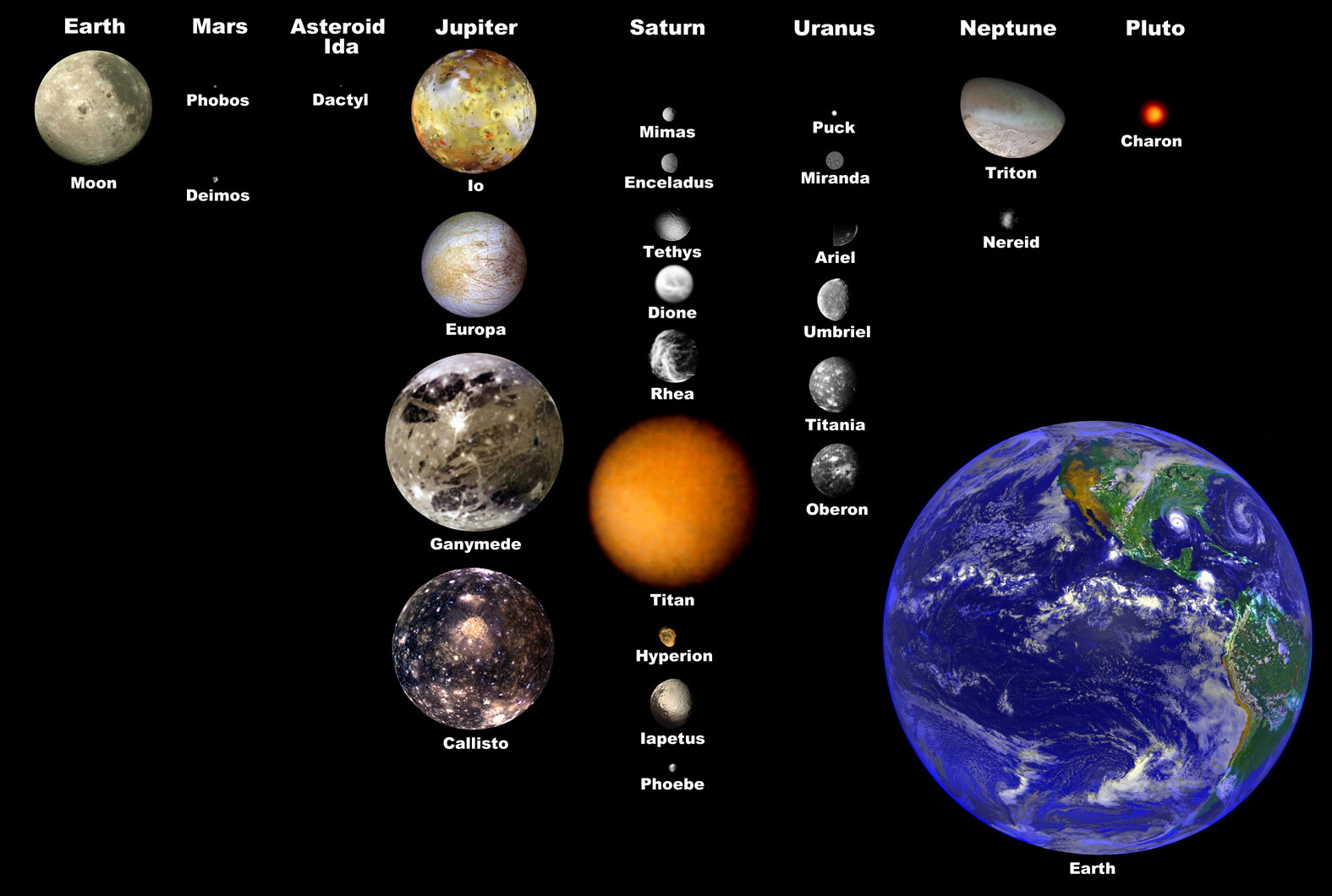

Moons are `fossils" into a planet's past. The major, named moon systems are (see diagram above):
Earth: Luna (The Moon)
Mars: Deimos, Phobos
Jupiter: Adrastea, Amalthea, Ananke, Callisto, Carme, Elara, Europa, Ganymede, Himalia, Io, Leda, Lysithea, Metis, Pasiphae, Sinope, Thebe
Saturn: Atlas, Calypso, Dione, Enceladus, Epimetheus, Helene, Hyperion, Iapetus, Janus, Mimas, Pan, Pandora, Phoebe, Prometheus, Rhea, Telesto, Tethys, Titan
Uranus: Ariel, Belinda, Bianca, Cordelia, Cressida, Desdemona, Juliet, Miranda, Oberon, Ophelia, Portia, Puck, Rosalind, Titania, Umbriel
Neptune: Despina, Galatea, Larissa, Naiad, Nereid, Proteus, Thalassa, Triton
Pluto: Charon (note: Pluto/Charon form a binary system, but Charon is the smaller so it is classed as the moon of Pluto)
New, smaller moons are being discovered all the time with recent space missions. The total count of moons (as of 2019) are:
Mercury - 0 moons Mars - 2 moons Uranus - 27 moons
Venus - 0 moons Jupiter - 129+ moons Neptune - 14 moons
Earth - 1 moon Saturn - 145+ moons Pluto - 5 moons
Moons range in shape from highly irregular to spheres. Their shape
reflects their formation history, irregular objects are ill-formed moons
(captured asteroids or comets) or pieces of a larger moon, spherical
objects were once molten spheres (called hydrostatic equilibrium), probably at the time of their formation.

Moons of Mars:
The two moons of Mars are Phobos and Deimos. Both moons were discovered in 1877 by Asaph Hall and are named after the characters Phobos (panic/fear) and Deimos (terror/dread) who, in Greek mythology, accompanied their father Ares, god of war, into battle. Ares was known as Mars to the Romans. It is possible that Mars may have moons smaller than 50-100 meters and a dust ring between Phobos and Deimos.

Deimos & Phobos
We speculate, from their irregular appearances and low mean densities, that Deimos and Phobos, are captured asteroids. Both Deimos and Phobos are saturated with craters. Deimos has a smoother appearance caused by partial filling of some of its craters.
The motions of Phobos and Deimos would appear very different from that of our own Moon. Speedy Phobos rises in the west, sets in the east, and rises again in just eleven hours, while Deimos, being only just outside synchronous orbit, rises as expected in the east but very slowly. Despite its 30-hour orbit, it takes 2.7 days to set in the west as it slowly falls behind the rotation of Mars.
Both moons are tidally locked, always presenting the same face towards Mars. Since Phobos orbits Mars faster than the planet itself rotates, tidal forces are slowly but steadily decreasing its orbital radius. At some point in the future, when it approaches Mars closely enough (see Roche limit), Phobos will be broken up by these tidal forces. Several strings of craters on the Martian surface, inclined further from the equator the older they are, suggest that there may have been other small moons that suffered the fate expected of Phobos, and that the Martian crust as a whole shifted between these events. Deimos, on the other hand, is far enough away that its orbit is being slowly boosted instead, as in the case of our own Moon.
Moons of Jupiter:
There are 79 known moons of Jupiter. This gives Jupiter the largest number of moons with reasonably stable orbits of any planet in the Solar System. The most massive of the moons are the four Galilean moons, which were independently discovered in 1610 by Galileo Galilei. Of Jupiter's moons, eight are regular satellites with prograde and nearly circular orbits that are not greatly inclined with respect to Jupiter's equatorial plane. The Galilean satellites are nearly spherical in shape due to their planetary mass, and so would be considered planets if they were in direct orbit around the Sun. The other four regular satellites are much smaller and closer to Jupiter; these serve as sources of the dust that makes up Jupiter's rings. The remainder of Jupiter's moons are irregular satellites whose prograde and retrograde orbits are much farther from Jupiter and have high inclinations and eccentricities. These moons were probably captured by Jupiter from solar orbits. Sixteen irregular satellites have been discovered since 2003 and have not yet been named.
Inner satellites or the Amalthea group are composed of Metis, Adrastea, Amalthea, and Thebe. These orbit very close to Jupiter; the innermost two orbit in less than a Jovian day. The latter two are respectively the fifth and seventh largest moons in the Jovian system. Observations suggest that at least the largest member, Amalthea, did not form on its present orbit, but farther from the planet, or that it is a captured Solar System body. These moons, along with a number of as-yet-unseen inner moonlets, replenish and maintain Jupiter's faint ring system. Metis and Adrastea help to maintain Jupiter's main ring, whereas Amalthea and Thebe each maintain their own faint outer rings.
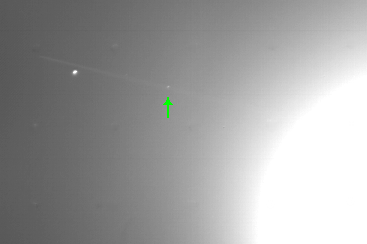
Adrastea is a typical small moon
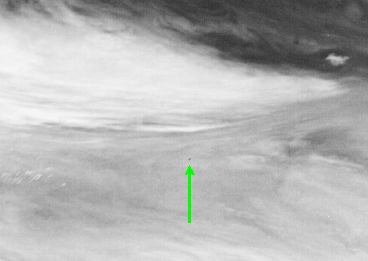
Metis is the innermost known satellite of Jupiter
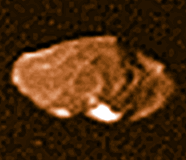
Amalthea is one of Jupiter's smaller, irregular moons, an example of moon collecting dust from another moon (Io)
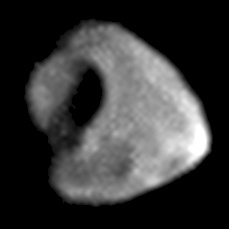
Thebe, the largest inner moon.
The remaining moons are irregular, they have a mixture of prograde and retrograde orbits with high inclinations and eccentricities. Jupiter's regular satellites are believed to have formed from a circumplanetary disk, a ring of accreting gas and solid debris analogous to a protoplanetary disk.
The irregular satellites are substantially smaller objects with more distant and eccentric orbits. They form families with shared similarities in orbit (semi-major axis, inclination, eccentricity) and composition; it is believed that these are at least partially collisional families that were created when larger (but still small) parent bodies were shattered by impacts from asteroids captured by Jupiter's gravitational field. These families bear the names of their largest members. The identification of satellite families is tentative, but the following are typically listed as either prograde or retrograde families.

Moons of Saturn:
The moons of Saturn are numerous and diverse, ranging from tiny moonlets less than 1 kilometer across to the enormous Titan, which is larger than the planet Mercury. Saturn has 71 moons with confirmed orbits, 53 of which have names and only 13 of which have diameters larger than 50 kilometers, as well as dense rings with complex orbital motions of their own. Seven Saturnian moons are large enough to be ellipsoidal in shape, though only two of those, Titan and Rhea, are currently in hydrostatic equilibrium. Particularly notable among Saturn's moons are Titan, the second-largest moon (after Jupiter's Ganymede) in the Solar System, with a nitrogen-rich Earth-like atmosphere and a landscape including hydrocarbon lakes and dry river networks; and Enceladus, which is seemingly similar in chemical makeup to comets, emits jets of gas and dust and may harbor liquid water under its south pole region.
Twenty-four of Saturn's moons are regular satellites; they have prograde orbits not greatly inclined to Saturn's equatorial plane. They include the seven major satellites, four small moons that exist in a trojan orbit with larger moons, two mutually co-orbital moons and two moons that act as shepherds of Saturn's F Ring. Two other known regular satellites orbit within gaps in Saturn's rings. The relatively large Hyperion is locked in a resonance with Titan. The remaining regular moons orbit near the outer edge of the A Ring, within G Ring and between the major moons Mimas and Enceladus. The regular satellites are traditionally named after Titans and Titanesses or other figures associated with the mythological Saturn.
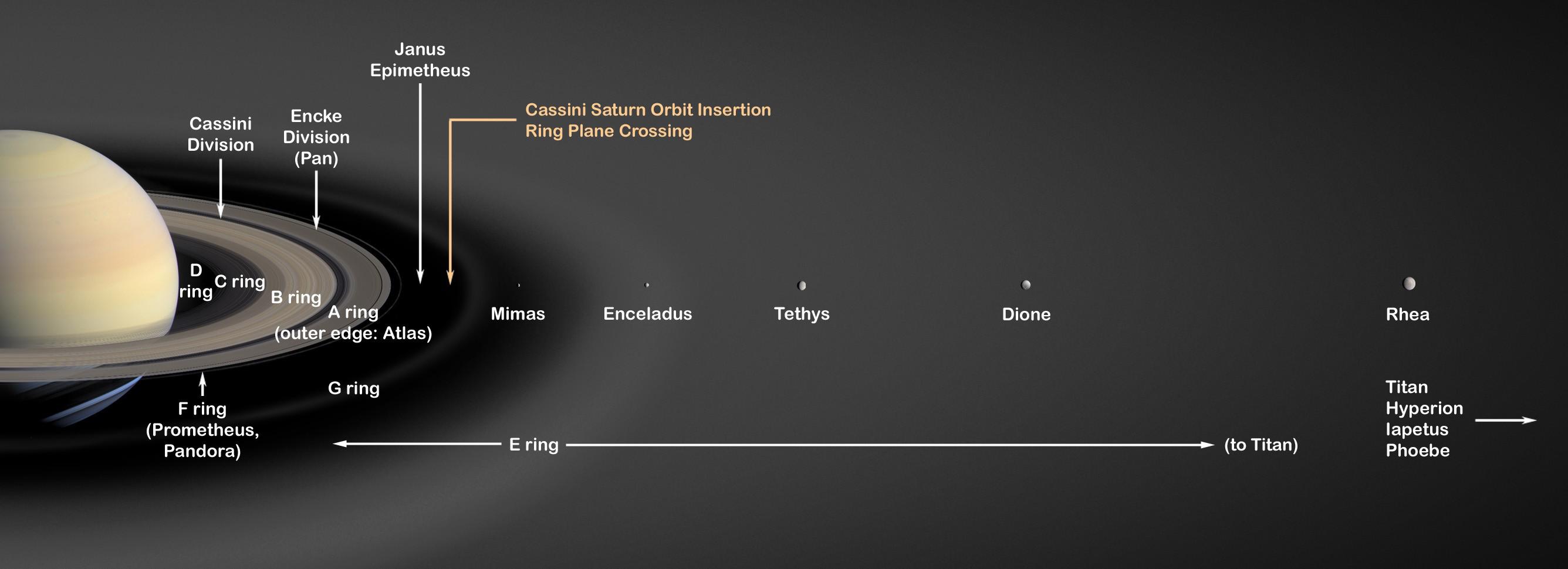
The remaining 38, all small except one, are irregular satellites, whose orbits are much farther from Saturn, have high inclinations, and are mixed between prograde and retrograde. These moons are probably captured minor planets, or debris from the breakup of such bodies after they were captured, creating collisional families. The irregular satellites have been classified by their orbital characteristics into the Inuit, Norse, and Gallic groups, and their names are chosen from the corresponding mythologies. The largest of the irregular moons is Phoebe, the ninth moon of Saturn, discovered at the end of the 19th century.

The rings of Saturn are made up of objects ranging in size from microscopic to hundreds of meters, each of which is on its own orbit about the planet. Thus, a precise number of Saturnian moons cannot be given, as there is no objective boundary between the countless small anonymous objects that form Saturn's ring system and the larger objects that have been named as moons. At least 150 moonlets embedded in the rings have been detected by the disturbance they create in the surrounding ring material, though this is thought to be only a small sample of the total population of such objects.
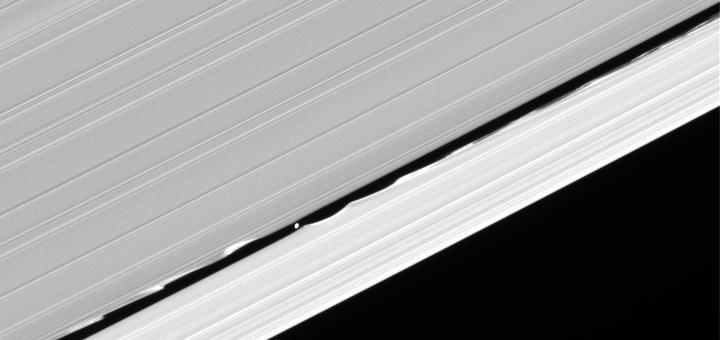
Daphnis drifts through the Keeler gap

Atlas the second of Saturn's known satellites, orbits near the outer edge of the A-ring
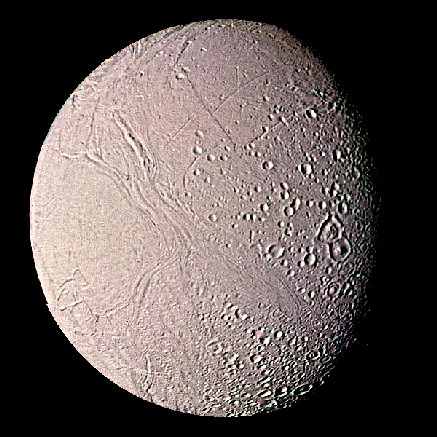
Enceladus is one of the smallest of Saturn's moons that is spherical in shape-only yet is the only small Saturnian moon that is currently endogenously active, and the smallest known body in the Solar System that is geologically active today. Its surface is morphologically diverse; it includes ancient heavily cratered terrain as well as younger smooth areas with few impact craters. Many plains on Enceladus are fractured and intersected by systems of lineaments. The area around its south pole was found by Cassini to be unusually warm and cut by a system of fractures about 130 km long called "tiger stripes", some of which emit jets of water vapor and dust. These jets form a large plume off its south pole, which replenishes Saturn's E ring and serves as the main source of ions in the magnetosphere of Saturn. The gas and dust are released with a rate of more than 100 kg/s. Enceladus may have liquid water underneath the south-polar surface. The source of the energy for this cryovolcanism is thought to be a 2:1 mean-motion resonance with Dione. The pure ice on the surface makes Enceladus one of the brightest known objects in the Solar System - its geometrical albedo is more than 140%.
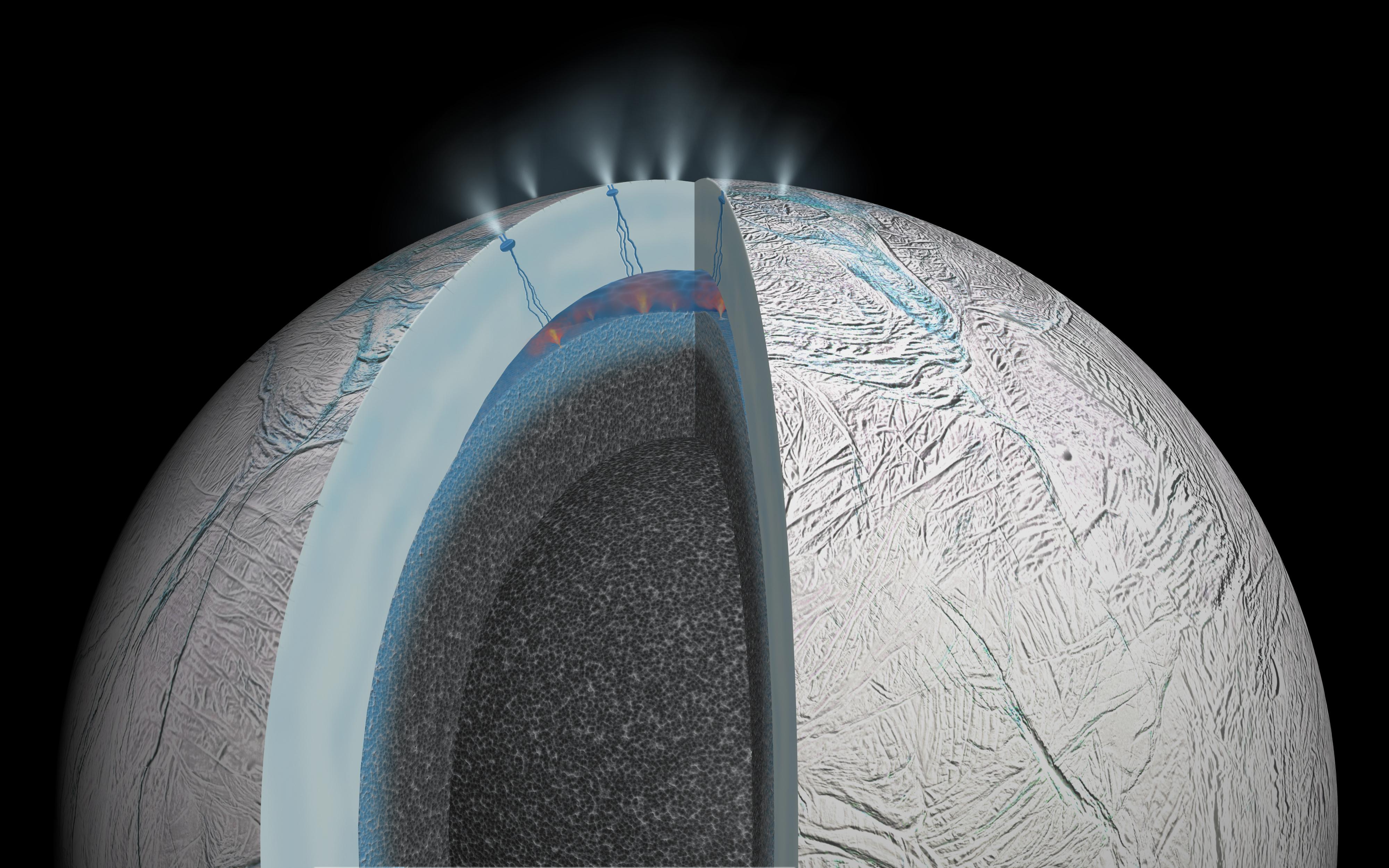
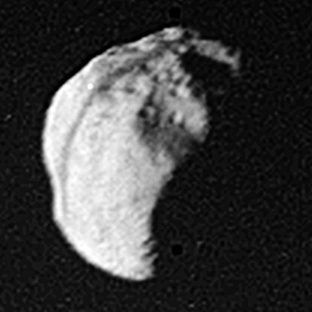
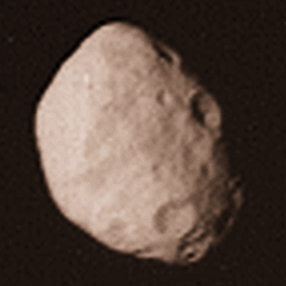

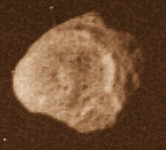
Hyperion is Titan's nearest neighbor in the Saturn system. The two moons are locked in a 4:3 mean-motion resonance with each other, meaning that while Titan makes four revolutions around Saturn, Hyperion makes exactly three. With an average diameter of about 270 km, Hyperion is smaller and lighter than Mimas. It has an extremely irregular shape, and a very odd, tan-colored icy surface resembling a sponge, though its interior may be partially porous as well. The average density of about 0.55 g/cm3 indicates that the porosity exceeds 40% even assuming it has a purely icy composition. The surface of Hyperion is covered with numerous impact craters - those with diameters 2-10 km are especially abundant. It is the only moon besides the small moons of Pluto known to have a chaotic rotation, which means Hyperion has no well-defined poles or equator. While on short timescales the satellite approximately rotates around its long axis at a rate of 72-75 degrees per day, on longer timescales its axis of rotation (spin vector) wanders chaotically across the sky. This makes the rotational behavior of Hyperion essentially unpredictable.
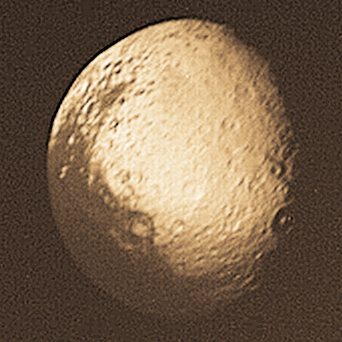
Iapetus is the third-largest of Saturn's moons. Orbiting the planet at 3.5 million km, it is by far the most distant of Saturn's large moons, and also has the largest orbital inclination, at 15.47 degrees. Iapetus has long been known for its unusual two-toned surface; its leading hemisphere is pitch-black and its trailing hemisphere is almost as bright as fresh snow. Cassini images showed that the dark material is confined to a large near-equatorial area on the leading hemisphere called Cassini Regio, which extends approximately from 40N to 40S. The pole regions of Iapetus are as bright as its trailing hemisphere. Cassini also discovered a 20 km tall equatorial ridge, which spans nearly the moon's entire equator. Otherwise both dark and bright surfaces of Iapetus are old and heavily cratered. The images revealed at least four large impact basins with diameters from 380 to 550 km and numerous smaller impact craters. No evidence of any endogenic activity has been discovered. A clue to the origin of the dark material covering part of Iapetus's starkly dichromatic surface may have been found in 2009, when NASA's Spitzer Space Telescope discovered a vast, nearly invisible disk around Saturn, just inside the orbit of the moon Phoebe - the Phoebe ring. Scientists believe that the disk originates from dust and ice particles kicked up by impacts on Phoebe. Because the disk particles, like Phoebe itself, orbit in the opposite direction to Iapetus, Iapetus collides with them as they drift in the direction of Saturn, darkening its leading hemisphere slightly. Once a difference in albedo, and hence in average temperature, was established between different regions of Iapetus, a thermal runaway process of water ice sublimation from warmer regions and deposition of water vapor onto colder regions ensued. Iapetus's present two-toned appearance results from the contrast between the bright, primarily ice-coated areas and regions of dark lag, the residue left behind after the loss of surface ice.
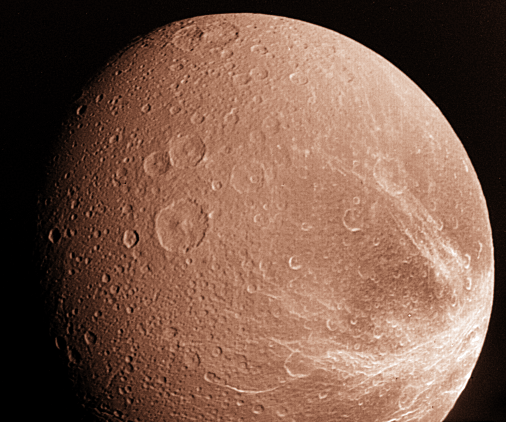
Dione is the densest moon of Saturn other than Titan, and has several usual characteristics: 1) has a rocky core and ice crust, 2) is heavy cratering on trailing hemisphere, 3) has bright, wispy features. Dione is the second-largest inner moon of Saturn. It has a higher density than the geologically dead Rhea, the largest inner moon, but lower than that of active Enceladus. While the majority of Dione's surface is heavily cratered old terrain, this moon is also covered with an extensive network of troughs and lineaments, indicating that in the past it had global tectonic activity. The troughs and lineaments are especially prominent on the trailing hemisphere, where several intersecting sets of fractures form what is called "wispy terrain". The cratered plains have a few large impact craters reaching 250 km in diameter. Smooth plains with low impact-crater counts are present as well on a small fraction its surface. They were probably tectonically resurfaced relatively later in the geological history of Dione. At two locations within smooth plains strange landforms (depressions) resembling oblong impact craters have been identified, both of which lie at the centers of radiating networks of cracks and troughs; these features may be cryovolcanic in origin. Dione may be geologically active even now, although on a scale much smaller than the cryovolcanism of Enceladus. This follows from Cassini magnetic measurements that show Dione is a net source of plasma in the magnetosphere of Saturn, much like Enceladus.
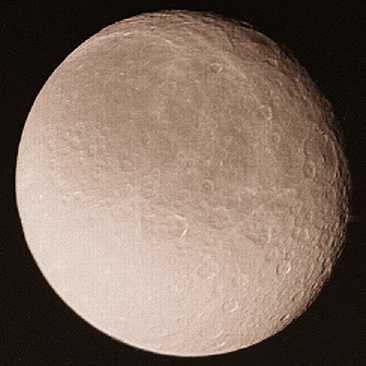
Rhea is the second-largest of Saturn's moons. In 2005 Cassini detected a depletion of electrons in the plasma wake of Rhea, which forms when the co-rotating plasma of Saturn's magnetosphere is absorbed by the moon. The depletion was hypothesized to be caused by the presence of dust-sized particles concentrated in a few faint equatorial rings. Such a ring system would make Rhea the only moon in the Solar System known to have rings. However, subsequent targeted observations of the putative ring plane from several angles by Cassini's narrow-angle camera turned up no evidence of the expected ring material, leaving the origin of the plasma observations unresolved. Otherwise Rhea has rather a typical heavily cratered surface, with the exceptions of a few large Dione-type fractures (wispy terrain) on the trailing hemisphere and a very faint "line" of material at the equator that may have been deposited by material deorbiting from present or former rings. Rhea also has two very large impact basins on its anti-Saturnian hemisphere, which are about 400 and 500 km across. The first, Tirawa, is roughly comparable to the Odysseus basin on Tethys. There is also a 48 km-diameter impact crater called Inktomi at 112W that is prominent because of an extended system of bright rays, which may be one of the youngest craters on the inner moons of Saturn. No evidence of any endogenic activity has been discovered on the surface of Rhea.
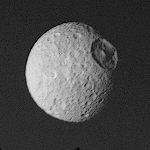
Mimas is one of the innermost moons of Saturn with a very large impact crater that came close to fracturing the moon

Tethys is the third largest of Saturn's inner moons. Its most prominent features are a large (400 km diameter) impact crater named Odysseus on its leading hemisphere and a vast canyon system named Ithaca Chasma extending at least 270 degrees around Tethys. The Ithaca Chasma is concentric with Odysseus, and these two features may be related. Tethys appears to have no current geological activity. A heavily cratered hilly terrain occupies the majority of its surface, while a smaller and smoother plains region lies on the hemisphere opposite to that of Odysseus. The plains contain fewer craters and are apparently younger. A sharp boundary separates them from the cratered terrain. There is also a system of extensional troughs radiating away from Odysseus. The density of Tethys (0.985 g/cm3) is less than that of water, indicating that it is made mainly of water ice with only a small fraction of rock.
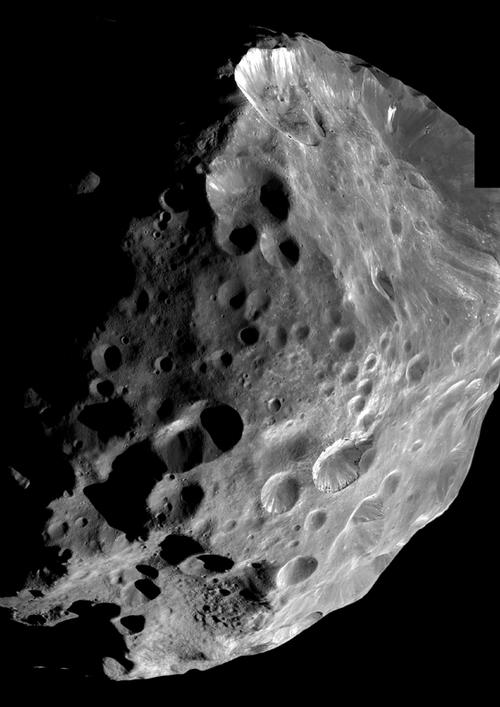
Phoebe is the last of the known satellites of Saturn and orbits in a retrograde direction (opposite to the direction of the other satellites' orbits) in a plane much closer to the ecliptic than to Saturn's equatorial plane. Thus, Phoebe may be a captured asteroid with a composition unmodified since the time it was formed in the outer Solar System.
Moons of Uranus:
Uranus is the seventh planet of the Solar System; it has 27 known moons, all of which are named after characters from the works of William Shakespeare and Alexander Pope. Uranus's moons are divided into three groups: thirteen inner moons, five major moons, and nine irregular moons. The inner moons are small dark bodies that share common properties and origins with Uranus's rings. The five major moons are massive enough to have reached hydrostatic equilibrium, and four of them show signs of internally driven processes such as canyon formation and volcanism on their surfaces. The largest of these five, Titania, is 1,578 km in diameter and the eighth-largest moon in the Solar System, and about one-twentieth the mass of the Moon. The orbits of the regular moons are nearly coplanar with Uranus's equator, which is tilted 97.77 degrees to its orbit. Uranus's irregular moons have elliptical and strongly inclined (mostly retrograde) orbits at large distances from the planet.
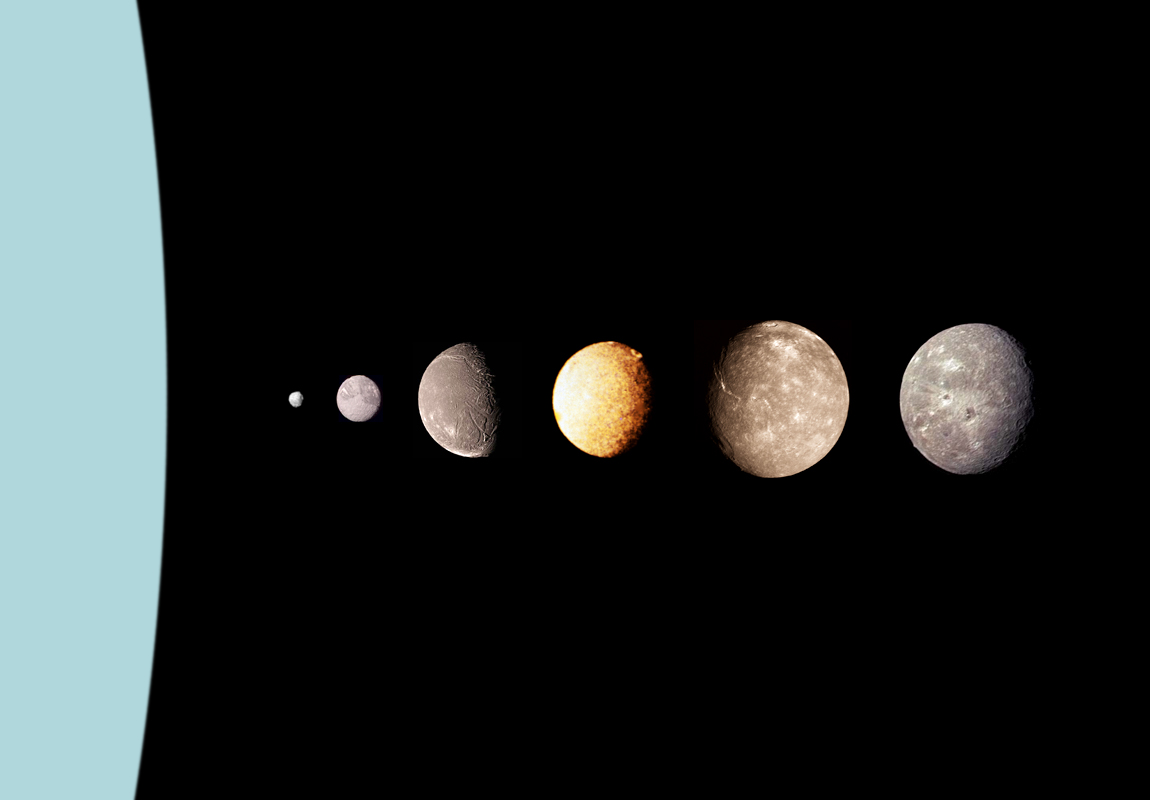
A montage of Uranus' large moons and one smaller moon: from left to right Puck, Miranda, Ariel, Umbriel, Titania and Oberon.
Uranian moons are divided into three groups: thirteen inner moons, five major moons, and nine irregular moons. The inner moons are small dark bodies that share common properties and origins with the planet's rings.

The five major moons are massive enough to have achieved hydrostatic equilibrium (they were once molten spheres), and four of them show signs of internally driven processes such as canyon formation and volcanism on their surfaces. The largest of these five, Titania, is 1,578 km in diameter and the eighth-largest moon in the Solar System, and about 20 times less massive than Earth's Moon. Uranus's irregular moons have elliptical and strongly inclined (mostly retrograde) orbits at great distances from the planet.
All major moons comprise approximately equal amounts rock and ice, except Miranda, which is made primarily of ice. The ice component may include ammonia and carbon dioxide. Their surfaces are heavily cratered, though all of them (except Umbriel) show signs of endogenic resurfacing in the form of lineaments (canyons) and, in the case of Miranda, ovoid race-track like structures called coronae. Extensional processes associated with upwelling diapirs are likely responsible for the origin of the coronae. Ariel appears to have the youngest surface with the fewest impact craters, while Umbriel's appears oldest. A past 3:1 orbital resonance between Miranda and Umbriel and a past 4:1 resonance between Ariel and Titania are thought to be responsible for the heating that caused substantial endogenic activity on Miranda and Ariel. One piece of evidence for such a past resonance is Miranda's unusually high orbital inclination (4.34 degrees) for a body so close to the planet. The largest Uranian moons may be internally differentiated, with rocky cores at their centers surrounded by ice mantles. Titania and Oberon may harbor liquid water oceans at the core/mantle boundary. The major moons of Uranus are airless bodies. For instance, Titania was shown to possess no atmosphere at a pressure larger than 1020 nanobars.
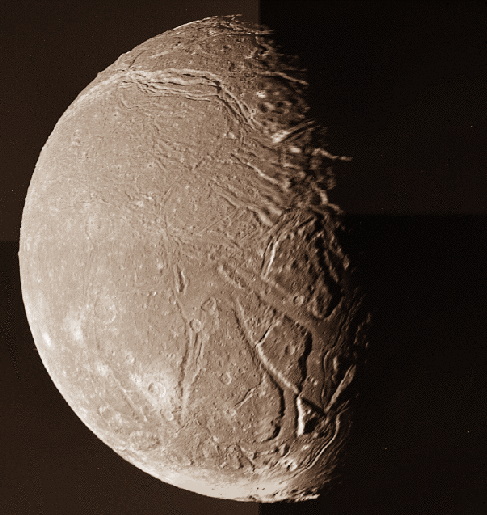
Ariel is a relatively small satellite and is the brightest moon of Uranus
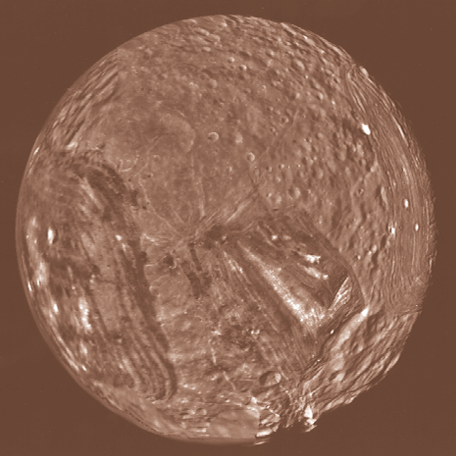
Miranda with a jumbled surface unlike anything in the Solar System, indicates evidence of violent past with possible multiple shattering and reassembly
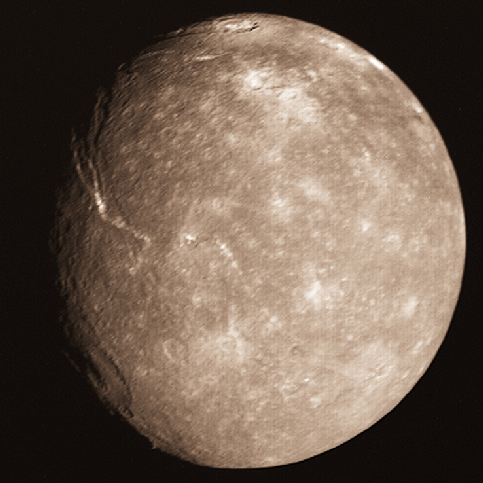
Titania is the largest moon of Uranus and is marked by a few large impact basins
Moons of Neptune:
Neptune has fourteen known moons, by far the largest of which is Triton, discovered by William Lassell just 17 days after the discovery of Neptune itself. Over a century passed before the discovery of the second natural satellite, called Nereid. Neptune's moons are named for minor water deities in Greek mythology.
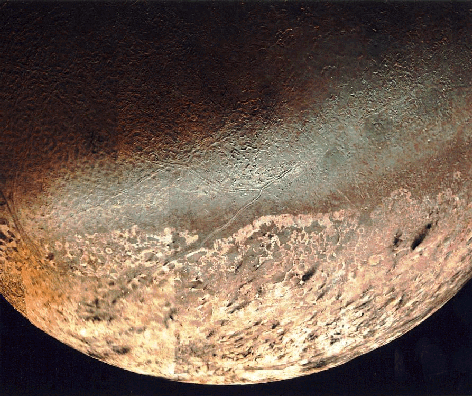
Unique among all large planetary moons, Triton is an irregular satellite, as its orbit is retrograde to Neptune's rotation and inclined relative to the planet's equator. The next-largest irregular satellite in the Solar System, Saturn's moon Phoebe, is only 0.03% Triton's mass. Triton is massive enough to have achieved hydrostatic equilibrium and to retain a thin atmosphere capable of forming clouds and hazes. Both its atmosphere and its surface are composed mainly of nitrogen with small amounts of methane and carbon monoxide. Triton's surface appears relatively young, and was probably modified by internally driven processes within the last few million years. The temperature at its surface is about 38K.
Inward of Triton are six regular satellites, all of which have prograde orbits in planes that lie close to Neptune's equatorial plane. Some of these orbit among Neptune's rings. The largest of them is Proteus.
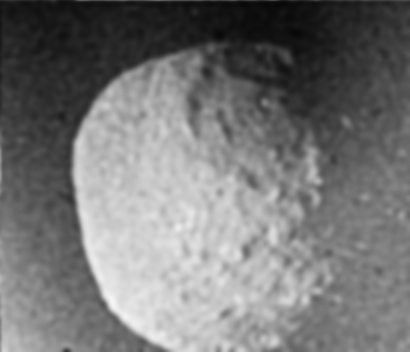
Neptune also has six outer irregular satellites, including Nereid, whose orbits are much farther from Neptune, have high inclinations, and are mixed between prograde and retrograde. The two outermost ones, Psamathe and Neso, have the largest orbits of any natural satellites discovered in the Solar System to date.
Proteus is one of the darkest objects in the Solar System

|
|

|